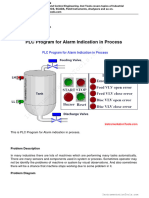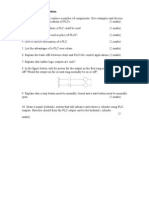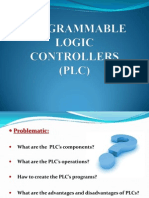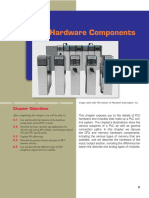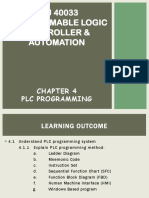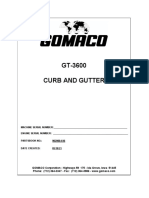CHAPTER 4:
PLC
PROGRAMMING
BAKISS HIYANA BT ABU BAKAR
�Course Learning Outcomes (CLO)
1. Explain clearly blocks, parts, components
and instructions found in the automation
systems. (C2)
2. Construct simple automation sequential
control of hardwired or PLC system based
on IEC 61131 and NEMA standards. (C4).
�Specific Objectives:
After completed this chapter, student will know the major
component
Familiarize with the PLC Programming system
Able to explain PLC programming method using Ladder
Diagram and mnemonic code, Instruction set and logic
function.
Understand and use Ladder Diagram and mnemonic code
to solve control systems circuits.
Explain the following logic instruction set: Load. Load Not,
Out, And, And Not, Or, Or Not, END, No Operation, And Ld
and Or Ld.
Explain sequential instruction set: Interlock, Jump, Keep,
Set/Reset, Move, Shift Register, Arithmetic Function and
Differential Up/Down.
Explain the timer and Counter instruction set and execute
timer/counter application solution methods.
Explain the combination logical function sequence.
�4.1 PLC PROGRAMMING SYSTEM
DEFINITION
An activity of planning, building
and
executing a program to perform
the
tasks required
�4.1 PLC PROGRAMMING SYSTEM
Here are the parts that should be there in a PLC
program:
�4.1.1 Famous PLC Programming Method
IEC 1131-3 is the international standard for programmable
controller programming languages.
The following is a list of programming languages specified
by this standard:
i. Ladder Diagram (LD)
ii. Mnemonic Code
iii. Instruction List/Set (IL)
iv. Function Block Diagram (FBD)
v. Sequential Function Chart (SFC)
vi. Structured Text (ST) /Windows Based program
One of the primary benefits of the standard is that it allows
multiple languages to be used within the same
programmable controller.
This allows the program developer to select the language
best suited to each particular task.
�i. Ladder Diagram (LD)
Ladder Diagram is kind of graphical programming
language that changed the relay control wiring circuit
diagram.
Ladder Diagram contains right and left vertical line to
represent bus bar, for +ve & -ve power line .
The horizontal line connects bus bar is called logic line
which placing of switching elements of n NO & NC and
OUTPUT
The combination of switching element is called as Rung
Ladder diagram also shows the control circuit and the
display function and a combination of the sequence of
operations for each branch of the horizontal lines
separately.
�Graphical diagram of Ladder Diagram
� Based on the picture above, one should note that a ladder
diagram consists of two basic parts: left section also called
conditional, and a right section which has instructions.
The pairs of vertical lines along the branch line is called the
conditions. These conditions consist of two, namely:
i. Normally open condition (NO)
ii. Normally closed condition (NC)
When a condition is fulfilled, instruction is executed.
�Notes:
Normally open condition is ON if the bit operation is ON and
will be OFF if the bit operation is OFF .
Normally closed condition is ON if the bit operation is OFF and
will be OFF if bit operation is ON.
�Comparison between relay wiring and
Ladder Diagram
RELAY WIRING
LADDER DIAGRAM
�ii. Mnemonic Code
These instructions can be
derived directly from the ladder
logic diagrams and entered into
the PLC through a simple
programming terminal.
Ladder diagrams can not be
read by the programming
Console.
Therefore Ladder Diagrams has
to be converted to mnemonic
code that provides the same
information as Ladder Diagram
and can be typed directly on
the console programming.
ADDRESS
INSTRUCTION
DATA
00000
LD
00000
00001
OR
00001
00002
AND
00003
00003
AND LD
00004
OUT
01000
00005
TIM
000
#0050
00006
CNT
002
#0010
00007
FUN 01
�iii. Instruction List/Set (IL)
This low-level language is similar to Assembly language and
is useful in cases where small functions are repeated often.
Although it is powerful, it is considered to be difficult to
learn.
Example:
Calculate new weight by subtracting tare weight from net
weight.
�iv. Function Block Diagram (FBD)
FBD is a graphical language that allows programming in
other languages (ladder, instruction list, or structured text)
to be nested within the FBD.
In FBD, program elements appear as blocks which are
"wired" together in a manner resembling a circuit diagram.
FBD is most useful in those applications involving a high
degree of information/data flow between control
components, such as process control.
The main concept is the data flow that start from inputs and
passes in block(s) and generate the output.
�v. Sequential Function Chart (SFC)
SFC have been developed to accommodate the
programming of more advanced systems.
These are similar to flowcharts, but much more powerful.
This method is much different from flowcharts because it
does not have to follow a single path through the flowchart.
SFC programming offers a graphical method of organizing
the program. The three main components of an SFC are
steps, actions and transitions.
�vi. Structured Text (ST) /Windows Based
program
Programming has been developed as a more modern
programming language. It is quite similar to languages such
as BASIC and Pascal.
ST is ideal for tasks requiring complex math, algorithms or
decision-making.
Its concise format allows a large algorithm to be displayed
on a single.
Benefits of Structured Text:
People trained in computer languages can easily program
control logic
Symbols make the programs easy to understand
Programs can be created in any text editor
Runs as fast as ladder
�Example 1
We have Motor that will be controlled manually by 2 push
buttons (Start Push Button, and Stop Push Button).
When the Start Push Button is pushed then the Motor will
be turned ON.
When the Stop Push Button is Pushed then we want to stop
the Motor. (Security logic has been taken off this logic, for
the purpose of demonstration.)
�4.1.2 Use ladder diagram and mnemonic codes
to solve control system circuits.
Example1:
� Example 2:
00000
00003
01000
instruction
00001
ADDRESS
INSTRUCTION
DATA
00000
LD
00000
00001
OR
00001
00002
AND
00003
00003
OUT
01000
00004
FUN 01
�Example 3:
00000
00002
01000
instruction
00001
00003
ADDRESS
INSTRUCTION
OPERAND / DATA
00000
LD
00000
00001
OR
00001
00002
LD
00002
00003
OR NOT
00003
00004
AND LD
------
00005
OUT
01000
00007
FUN 01
�Basic Terms
�1. Execution Conditions
Logical combination of the ON and OFF states gathered to
establish an instruction to be implemented. This condition is
called Execution Condition. Refer to figure below.
Instructions will be in the Execution Conditions ON when IR
00000 is ON, IR 00001 is OFF and IR 00002 is ON.
�DATA AREAS
2. Operand Bits
IR area
Output
area
Bit operations for every
instruction can be of
any bit in memory areas
of IR, SR, HR, TC or TR.
It shows that conditions
in Ladder Diagram can
be decided by I/O bit,
flags, work bits, timers/
counters etc.
Table shows the
memory map refers to
the PLC type SYSMAC
OMRON-CQM1H
Input
area
Work
area
BITS
IR00000 IR00915
IR01000
IR01915
FUNCTIONS
Used as input bit
Used as output bit
IR02000
IR04915
IR20000
IR23115
Freely used in a
program. No specific
function.
SR area
SR22800
SR25515
Bit used as flags and
control bit.
TR area
TR 0 TR 7
Bit used to store
temporary the ON/OFF
status at program
junction
HR area
HR 0000
HR 1915
Bit used to store data and
ON/OFF status when
power off
TC 000 TC
255
The same number is used
for timer and counter.
TC000 to TC002 used for
`interval timer
Area for
Timer/Counter
�3. Logic Block
The respond to an instruction is determined by the
relationship between the conditions on the instruction line
that connects them.
Any group of conditions that formed to produce a logical
result is called a logical block.
�4. Instruction Block
A block of instruction is composed of all the instructions
contained in a block.
Block is obtained by drawing a horizontal line without
cutting a vertical line and vice versa.
�HOW PLC WORKS ?
A PLC works by continually scanning a program
with consisting of 3 important steps
�1. SCANNING
Scanning is the process of CPU
�2. CHECK INPUT STATUS
First the PLC takes a look at each input to determine if it is
on or off. In other words, is the sensor connected to the
first input on?
How about the second input? How about the third... It
records this data into its memory to be used during the
next step. 3. EXECUTE PROGRAM
Next the PLC executes your program one instruction at a
time. Maybe your program said that if the first input was
on then it4.
should
turn onOUTPUT
the first output.
UPDATE
STATUS
Finally the PLC updates the status of the outputs. It
updates the outputs based on which inputs were on during
the first step and the results of executing your program
during the second step.
�4.2 BASIC LOGIC INSTRUCTION
SET
There are a lot of instructions used to
develop the PLC program.
Each instruction has a respective
function.
�4.2.1 Basic Logic Instruction
a) Load (LD):
) These instructions are use to start a line of the
program.
) It is used in the first contacts in the normally open
condition (NO).
Ladder Diagram
Mnemonic Code
00000
01000
OUTPUT
Address
Instruction
Operand/Data
00000
LD
00000
00001
OUT
01000
Explanation:
The Execution Conditions of the instruction on the right
will be ON when IR 00000 is ON.
�Load Not (LD Not):
These instructions are use to start a line of the
program.
It is used in the first contacts in the normally
closed condition (NC).
Ladder Diagram
Mnemonic Code
00000
01000
output
address
Instruction
Operand/Data
00000
LD NOT
00000
00001
OUT
01000
Explanation
The Execution Conditions of the instruction on the right will
be ON when IR 00000 is OFF
�b) And (AND):
These instructions are used in the second contact in a
normally open (NO) and a series with previous
contacts
Ladder Diagram
Code
00000
01000
00001
output
Mnemonic
Alamat
Arahan
Operand/Data
00000
LD
00000
00001
AND
00001
00002
OUT
01000
Explanation
The Execution Conditions of the instruction on the right will
be ON when IR 00000 and IR 00001 are ON
�And Not (AND NOT):
These instructions are used in the second contact in a
normally closed (NC) and in series with previous
contacts
Ladder Diagram
Code
00000
01000
00001
output
Mnemonic
Address
instruction
Operand/Data
00000
LD
00000
00001
AND
00001
00002
OUT
01000
Explanation
The Execution Conditions of the instruction on the right will
be ON when IR 00000 ON and IR 00001 are OFF.
�c) Or (OR):
These instructions are used in the second contact in a
normally open (NO) and in line (parallel) with
previous contacts.
Ladder Diagram
Code
00000
01000
00001
Mnemonic
address
instruction
Operand/Data
00000
LD
00000
00001
OR
00001
00002
OUT
01000
output
Explanation
The Execution Conditions of the instruction on the right
will be ON when either IR 00000 or IR 00001 are ON.
�Or Not (OR NOT):
These instructions are used in the second contact in a
normally closed (NC) and in line (parallel) with
previous contacts.
Ladder Diagram
Code
00000
00001
01000
OUTPUT
Mnemonic
Address
instruction
Operand/Data
00000
LD
00000
00001
OR NOT
00001
00002
OUT
01000
Explanation
The Execution Conditions of the instruction on the right will be
ON when either IR 00000 is ON or IR 00001 is OFF or IR 00000
ON, IR 00001 OFF simultaneously
�d) Out (OUT):
These instructions are used for the coil output.
Ladder Diagram
Code
00000
01000
Mnemonic
address
instruction
Operand/Data
00000
LD
00000
00001
OUT
10000
IR 10000 will ON when IR 00000 is ON .
�e) END (FUN (01):
END instruction has no physical contact device.
It is the last instruction required for completion of a
program.
If no END instruction, the program cannot be implemented
Ladder Diagram
Code
01000
00000
00001
END
Mnemonic
address
instruction
Operand/Data
00000
LD
00000
00001
AND NOT
00001
00002
OUT
01000
00003
FUN 01
For PLC type OMRON - SYSMAC CQM1H, the instruction FUN 01 is
the END instruction.
�f) And Load (AND LD):
The AND LD no physical contact device.
Only a programming tool for solving complex
functions such as AND connects a number of OR, OR
NOT, OR LD in the series.
Ladder Diagram
Code
Mnemonic
�f) And Load (AND LD):
o AND LD instruction is used to connect parallel blocks in
series.
o Example:
�f) And Load (AND LD):
o The AND LD instruction must be used if the element or
serial block is in front of the parallel block.
o If the parallel block is in front of the element or serial block,
AND instruction can be used to connect all parts together.
o Example:
�Example AND LD:
o Remark: If there are more than two blocks are to be
connected serially, they should be connected in a top to
bottom sequence.
o For example, block 1 and 2 should be connected first, then
connect block 3 to it and so on.
�g) OR load (OR LD):
The OR LD instruction has no physical contact device.
Only a programming tool for solving complex OR function as
a series of contacts LD (or LD NOT), in parallel with a series
of other contacts.
Ladder Diagram
Code
Mnemonic
�Example OR LD:
o Remark If more than two blocks are to be connected in
parallel, they should be connected in a top to bottom
sequence.
o For example, block 1 and block 2 should be connected first,
then connect block 3 to it and so on.
�OR LD and AND LD:
When both logic block instruction is to be used in Ladder
Diagram, a program must be written from the bottom
up to merge logic blocks.
For example, ladder diagram below:
Logic block of instruction for the last two blocks (blocks b1
and b2 blocks) are written first and then followed by the
first logic block instruction (block a).
��h) No operation (NOP):
These instructions do not have a ladder diagram symbols
and will not do any operations.
When you remove the memory in this instruction will be
displayed on the console screen PLC programming.
�De-composition of a network
The key process of de-composition of a network is to separate
the circuits that appear between two vertical lines into
independent elements and serial blocks, then coding those
elements and serial blocks according to the mnemonic coding
rules and then connect them (with ANDLD or ORLD instruction)
from left to right and top to bottom to form a parallel or a
serial-parallel blocks, and finally to form a complete network.
Sample diagram:
��A systematic approach of Control System
Design using A PLC
1.
2.
3.
4.
5.
Determine the machine sequence of operation.
Assignment of input & output.
Writing the program / construct ladder diagram.
Convert to mnemonic code.
Running the system.
�Example Approach of Control System Design:
Design the following sequences:
A grind machine need to be continuously function when
ON button, S1 is pressed and only OFF when stop button,
S2 is pressed.
STEP 1: The machine sequence:
The activity
The sequence
S1 ; ON
Motor, M1 ; ON
S2 ; ON
Motor, M1 ; OFF
STEP 2: I/O assignment:
Input
Descriptio
n
Output
Descriptio
n
00001
S1
01001
M1
00002
S2
�STEP 3: Ladder Diagram:
00001
01001
S1
S2
00002
M1
M1
01001
END
STEP 4: Mnemonic code:
Address
Instructio
n
Data
00000
LD
00001
00001
OR
01001
00002
AND NOT
00002
00003
OUT
01001
00004
FUN(01)
�4.3 SPECIAL SEQUENTIAL INSTRUCTION
SET
A sequence of instructions which usually acts as the last
instruction in the instruction line.
Instruction sequence SET, RESET, KEEP, DIFFERENTIATE
UP, DOWN DIFFERENTIATE, used to ON and OFF state
output bits in the IR. These instructions are used to control
the status of the other bits in the IR or in other areas.
INTERLOCK instruction sequences can overcome the
problem of storing execution conditions, in the branches
of the ladder diagram.
JUMP instruction sequence can be used to control devices
that require a product that can last a long time.
�a) Keep (FUN (11)):
KEEP instruction is used to maintain the status bit
operation based on two state execution condition.
KEEP (11) operates like a Latching Relay which is set by
S and reset by R.
When S is in the ON state, the operation of a particular
product instruction is ON and remain ON until reset,
regardless of whether S is ON or OFF.
When R is in the ON state, the operation of a particular
product instruction is OFF and remain OFF until reset,
regardless of whether R is ON or OFF.
For PLC type OMRON - SYSMAC CQM1H, the instruction FUN
11 is KEEP instruction.
�Ladder Diagram shows KEEP instruction
Explanation
o Instruction LD 00 002 acts as S (Set)-and the LD 00 003 acts
as R (Reset).
o When the instruction LD 00 002 ON, the output instruction
OUT 10004 will be ON and will remain ON even if the
instruction LD 00 002 is OFF.
o When the instruction LD 00 003 ON, then the output OUT
10004 instruction OFF and will remain OFF even though the
instruction LD 00 002 in OFF or ON state.
�Ladder Diagram shows KEEP
instruction
Operation table
00002
00003
HR000
01004
Timing diagram
�b) Set/Reset (SET/RESET):
SET and RESET instruction will change the status of bit
operations only when the implementation is ON.
In the OFF condition, the instructions will not change the bit
operation status.
Ladder Diagram shows the Set and Reset
instruction
�Mnemonic Code
Explanation
When the input instruction LD 00 000 is ON, SET instruction
command to ON and always ON regardless of whether the
input instruction LD 00 000 is ON or OFF.
When the inputs instruction LD 00 001 is ON, RESET
instruction is ON and SET instruction will be off .
Its operations can be understood clearly in the KEEP
instruction.
�c) Jump (FUN(04)) & Jump End (FUN (05)):
Instructions JMP (04) is usually used in pairs with the
command JME (05) for the jump.
JMP (04) is a command to determine the starting point of
the jump and JME (05) is the instruction that the
direction of the jump.( where to jump).
When the instruction JMP (04) is ON, no jump will occur and
the program will be implemented as written.
When the instruction JMP (04) is OFF, a jump to the
instruction JME (05) which has the same number will be
done. Further instructions are the instructions JME (05) will
be implemented.
�o Instructions JUMP and JUMP END can use the numbers from
the range of 00 to 99.
o To set the instruction for PLC type OMRON - SYSMAC CQM1H,
is FUN 04 for JUMP instruction and FUN 05 instruction is
the JUMP END instruction.
Ladder Diagram shows JUMP instruction
�Mnemonic Code
Explanation
o When the input instruction LD 00000 is ON, instruction JMP
(04) will be ON. Subsequent instructions will be
implemented as written.
o If the input instruction LD 00 001 is ON, output instruction
OUT 10000 will be ON.
o If the input instruction LD 00 001 is OFF, output instruction
OUT 10000 will be OFF.
�00000
00001
01000
Operation table
Timing diagram
o When the input instruction LD 00 000 is OFF, instruction JMP
(04) will be OFF. Next jumps to Instruction JME (05) will
occur.
o
All instruction that is between JMP (04) and JME (05) will be
ignored.
o Refer to the table above.
�d) Interlock (FUN (02)) & Interlock Clear (FUN
(03)):
IL (02) and ILC (03) must be used together.
These instructions are used to solve the problem of
storing execution conditions at branch points.
When the INTERLOCK instruction is ON as shown in Ladder
Diagram, the implementation of the INTERLOCK instruction
will control all of the instruction execution until the
instruction INTERLOCK CLEAR.
When the INTERLOCK instruction is OFF, INTERLOCK CLEAR
instruction will reset the program operation.
� To set the INTERLOCK instruction for PLC type OMRON SYSMAC CQM1H is FUN 02 for INTERLOCK instruction
and FUN 03 is INTERLOCK CLEAR instruction.
0000
00001
1000
Ladder Diagram shows IL ( 02 )
dan ILC ( 03 )
T1
Timing
T2
T3
diagram
T4
�Mnemonic Code
Explanation
When the instruction input LD 00 000 is ON, the instruction
IL (02) will be ON.
Instruction output OUT 10 000 will depend on the
instruction input ON LD 00001 and LD 00000.
If the input instruction LD 00 001 ON, output OUT 10000
will be ON.
If the input instruction LD 00 001 OFF, output OUT 10000
will be OFF.
�Refer the table below:
In the event that the input instructions LD 00 000 OFF,
instruction IL (02) is OFF.
Instructions to the output OUT 10 000 will be OFF.
Next program ILC (03) will reset the program.
�e) Differentiate Up (FUN (13))/Down (FUN
(14)):
DIFU instructions (13) and DIFD (14) will ON the output
within a very short time.
Instructions DIFU (13) will turn the output to ON when the
input signal changes from OFF to ON.
Instructions DIFD (14) will turn the output to ON when the
input signal changes from ON to OFF.
For PLC type of OMRON - SYSMAC CQM1H, instruction FUN
13 is instruction DIFFERENTIATE UP and FUN 14 is
instruction DIFFERENTIATE DOWN.
�Ladder Diagram shows
DIFFERENTIATE UP instruction
Mnemonic Code
01001
0000
01000
Referring to Ladder Diagram,
o When the input instruction LD 00000 is ON (has changes from OFF
01001
to ON), operand bit 01 000
willT2be ON,
the output
OUT 10000 will
T1
T3
T4
be ON within a very short time and then OFF.
o We can not see the situation in the products.
o After that the operand bit 01 000 will be OFF regardless of the
status of the input instruction LD 00 000.
�Ladder Diagram shows the
DIFFERENTIATE DOWN instruction
Mnemonic Code
01001
0000
01000
Referring to Ladder Diagram,
When the input instruction LD 00 000 is OFF (change from ON to
01001
OFF), operand bit 01000T1will be
ON, the
output
OUT 10000 will be
T2
T3
T4
ON within a very short time and then OFF.
We can not see the situation in the products.
After that the operand bit 01000 will be OFF regardless of the
status of the input instruction LD 00 000.
�f) Move (FUN (21)):
MOVE instruction copy data from source channel to
destination channel.
IR is the memory areas that can be used for MOVE
instruction.
To set the instruction for PLC type OMRON - SYSMAC
CQM1H, FUN (21) is instruction for MOVE.
Symbol:
Ladder diagram:
� Mnemonic code:
Referring to Ladder Diagram,
When the input instruction LD 00000 ON, all data in IR000
will be copy into IR100.
�g) Shift Register (SFT (10)):
Shift Register ( SFT ) move 16 bit data, bit by bit which are 1
or 0 in a certain channel.
Each bit 1 or 0 represent 1 condition.
Symbol:
SFT ( 10 ) control by three execution condition which are DI ,
CP and R.
S and E must in the same memory area such as IR, SR, AR,
HR or LR.
� S is at right side of the shift register and E is at left side of
the adalah shift register.
If DI is ON, ` 1 will be move into the register.
If DI is OFF, ` 0 will be move into the register.
When DI move into register, all original bit in the register
will be move to the left.
The last left side bit will be delete.
When R is ON, it will RESET the operation and all bit in the
register will change to 0.
Data
being
delet
e
� Ladder diagram:
Mnemonic code:
�h) Arithmetic Function:
SET CARRY STC (40) FUN(40):
Symbol:
If the execution condition OFF, instruction STC ( 40 ) will not
function.
If execution condition ON, instruction STC ( 40 ) will ON carry
( Cy ).
SR25504 is carry flag that will ON if carry occur in execution
condition.
To set the instruction for PLC type OMRON - SYSMAC CQM1H,
FUN (40) is instruction for SET CARRY.
�CLEAR CARRY CLC (41)- FUN (41):
Symbol:
If the execution condition OFF, instruction CLC ( 41 ) will not
function.
If the execution condition ON, instruction CLC ( 41 ) will OFF
Cy ( SR25504 ).
CLEAR CARRY use to reset Cy ( 25504 ) to `0.
To set the instruction for PLC type OMRON - SYSMAC CQM1H,
FUN (41) is instruction for CLEAR CARRY.
�ADD ADD(30)- FUN (30):
Symbol:
Instruction ADD is use to add data from two different
channel and the total result will be store in the third channel.
The three channel are:
Augend Channel ( Au )
Addend Channel ( Ad )
Result Channel ( R ).
The range of number for Au dan Ad are # 0000 to # FFFF.
To set the instruction for PLC type OMRON - SYSMAC CQM1H,
FUN (30) is instruction for ADD ( 30 ).
�ADD process:
Result will be store in R.
Cy will be set if the result > # 9999.
Ladder diagram:
Mnemonic code:
Refer to ladder diagram:
o Instruction CLC ( 41 ) will reset Cy to ` 0 .
o 21600 to 21915 is bit that dont have any specific
function, so can be freely use.
o ADD result will be store at IR100.
�EXAMPLE 1:
�EXAMPLE 2:
�SUBTRACT SUB ( 31 )- FUN (31):
Symbol:
Instruction SUB is to find the different between 2 data from 2
different channel and the result will be store in the third
channel.
The three channel are:
Minuend ( Mi )
Subtrahend ( Su )
Result ( R ).
The range of number for Mi dan Su are # 0000 to # FFFF.
To set the instruction for PLC type OMRON - SYSMAC CQM1H,
FUN (31) is instruction for SUBTRACT (31)
�SUBTRACT process:
Ladder diagram:
Mnemonic code:
�EXAMPLE 1:
�COMPARE CMP ( 20 )- FUN (20):
Symbol:
Instruction CMP use to compare 2 data from 2 different
channel.
To set the instruction for PLC type OMRON - SYSMAC CQM1H,
FUN (20) is instruction for COMPARE (20).
The COMPARE result can be either one of the three
condition:
Greater than (GR)
Less than (LE)
Equal to the data (EQ)
� Address for COMPARE instruction:
Ladder diagram:
� Mnemonic code:
Compare Result:
Refer to ladder diagram:
o 10 will be compare with 5.
o Result: 10 > 5.
o So, OUT 10000 will ON
Explanation:
TR use to temporary store the status ON/OFF at the
instruction branch. Bit TR are from TR0 until TR 7.
When instruction LD 00000 ON, instruction CMP ( 20 ) will
execute.
Instruction COMPARE will compare the value in C1 with the
value in C2. Refer to the table above.
�4.3.2 Build program using special sequential
instructions set
EXAMPLE 1:
A burglar alarm is activated by N.O push button, placed on a
door, D1 and window, W1.
When the alarm is armed and a door or window is opened,
the alarm will trigger ON.
The only way to turn OFF the alarm is by disable the power
supply or hit the reset button, S1.
Draw the PLC ladder diagram and write the mnemonic code
to execute the control action.
�4.4 TIMER & COUNTER INSTRUCTION
TIMER (TIM) and COUNTER (CNT) is the instructions that
require numbers TIM / CNT (N) and the set value(SV).
The range of numbers TIM / CNT is from 000 to 255, while
the range of set values for the TIM / CNT is #0000 to
#9999.
The numbers TIM / CNT can not be used twice. When a
number has been used as definer, such as number 000 for
instructions on TIM / CNT, the number can not be used
again.
When a number is defined as the number of TIM / CNT, it
can be used as often as required as an operator operand in
other instructions from the command TIMER or COUNTER.
�4.4.1 Timer Instruction Set
Symbol:
Timer numbers (N) is between 000 and 255.
The set value (SV) is between 0000 to 9999.
All numbers TIM / CNT can be used as definer in only one
TIMER or COUNTER instruction.
TIMER is enabled/activated when the execution condition is
ON and will be reset to set value (SV) when the execution
condition is OFF.
The set value (SV) of TIMER is the BCD between # 0000 to
# 9999.
For example, if TIMER be set to 5 seconds, then the set
value (SV) is # 0050.
�4.4.2 Timer Application Solution
Method
�Example 1:
Operating Condition:
When the input (LD 00000) is ON, the timer contact will be
activated after 5 seconds.
Next, the output (OUT 10000) will be ON.
0000
5 sec
TIM000
Timing diagram
�Example 2:
Operating Condition:
When the input (LD 00000) ON, the timer (TIM 000) will be
activated after 5 seconds and the output (OUT 10000) will be
ON.
While the output (OUT 10 001) will be ON as soon as the
supply is supplied and will be OFF after 5 seconds.
Timer will continue to be active as long as the input 00000
state is ON.
�Example 3:
Operating Condition:
When the input (LD 00000) ON, the timer (TIM 000) will be activated
after 5 seconds. Next the output (OUT 10000) will be ON.
After 3 seconds the output (OUT 10000) ON, the timer (TIM 001) will
be activated the next output (OUT 10000) will be OFF and the timer
(TIM 001) will be OFF.
When the timer TM001 OFF, contact TIM 001 (NC) will be ON and the
output (OUT 10000) is ON state.
Output (OUT 10000) will continue ON and OFF until the input (LD
00000) in the OFF state.
�4.4.3 Counter Instruction Set
Symbol:
Number TIM / CNT can be used as definer for either timer or
counter.
Counter numbers are range from 000 to 255.
Counters are used to calculate the count down from the
set value (SV) on the execution condition on the
counting pulse (CP) when it is changed from OFF to ON.
The set value (SV) is range 0000 to 9999.
Counters will reset to the reset (R).
�4.4.4 Counter Application Solution
Method
�Example 1:
Operating Condition
Counter set to count 10. When the input (LD 00,000) is the
pulse of ten, a counter will be activated and thus the output
(OUT 10000) will be ON.
When reset (LD 00,001) ON, a counter will be in original
condition
�Timing Diagram:
0000
0001
CNT 001
1000
�4.5 COMBINED LOGICAL FUNCTION
SEQUENCE
The Application Of Timer And Counter Instructions:
The number of Counter cannot be the same number to the
number of timer because both share the same data in the
PLC memory.
Operating Condition:
Ladder diagram:
0001
o Counter set to count 5. When the
input (LD 00,000) is the pulse of
five, a counter will be activated and
thus the output (OUT 10000) will be
ON.
o When the output (OUT 10000)
ON, TIM 001 will be activated after
5 seconds and then the output (OUT
10 001) will be ON.
o Both the output (OUT 10000) and
(OUT 10 001) will always be ON
until reset (LD 00001) in the ON
state.
o Reset will return the counter to
�Timing Diagram:
0000
0001
CNT 000
TIM001
5 SEC
5 SEC
1000
1001
5 SEC
5 SEC
�EXAMPLE 1 (Timer And Counter Instructions)
The carrier is moved by the forward/reverse motor. The initial position
of the carrier is the left position indicated by the limit switch S4. When
the start push button, S1 is pressed (then release), the carrier will be
loaded with 5 pieces of product, which is sense by photo sensor S3
before it moves to the right until it touches the right limit switch S5,
the automatic carrier will halt for 5 seconds before it reverse to the
left. Once it touches S4, the carrier stop until it is sufficiently loaded.
Then it starts conveying again. The stop button, S2 stops the motor
regardless of which direction it is turning.
Study the description as given. Then design a ladder diagram and
mnemonic code by applying Five (5) sequences of programming
Conveyor
Sensor (S3)
method. Start ( S1)
belt
Stop (S2)
LS1
(s4)
LS2 (S5)
carrier
carrier
A
M1
M2
�EXAMPLE 2:
Design a program that will monitor & control the conveyor
system for material testing while adhering the following
criteria:
The start button will be used to start the conveyor.
The stop button will be used to stop the conveyor if
emergency occur.
2 sensor which are inductive sensor and through beam
sensor.
The conveyor will halt at through beam sensor when
material available for 5 seconds.
If there is non-metal material, the conveyor will continue
to run.
If there is metal material, the conveyor will halt again at
inductive sensor for 10 seconds.










